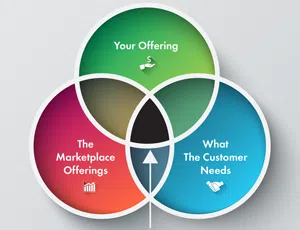Understand the difference between value and price — and its impact on the sales experience
Customer value is commonly discussed, universally seen as important, yet is difficult to define. Value is comprised of two key elements, the benefit the item or service brings to the consumer, and the cost of acquiring and using the item.
Value and price are not the same thing. Value is the benefit the product or service brings at a cost. Benefit and Cost are components of value. A critical factor is that benefit level is unique for each consumer. Their situation determines how highly they benefit.
Benefit vs. Cost
The relationship between benefit and cost determines the value to the customer. The relationship isn’t only linear since customers spend more than cash. They may also consider time, effort, convenience and energy in the value equation.
The “benefits” might include: quality, ownership advantages, brand, experience, knowledge and image.
The darkened area in the graphic above represents the intersection of the customer’s needs, the marketplace offerings and your offering. A key component in this process is communicating with the customer and listening actively to identify their needs. Your goal is to solve their problem, interest or need. You must be viewed as experts in their areas. You’re successful when you can use your product in the solution.
Another way of viewing value is it’s “the perception of what a product or service is worth to a customer versus the possible alternative.” It’s composed of unique “pieces” having meaning to the potential consumer. These are not necessarily readily identified by the seller.
Three Bain & Company consultants (Almquist, Senior and Block) have constructed a value pyramid, like Maslow’s Hierarchy, identifying and prioritizing the 30 values consumers use when considering their purchases. The researchers determined that companies that performed well on multiple value elements have more loyal customers and grow faster.
Also, digital retailers can explain their explosive success to their use of multiple elements. The research also analyzed these 30 value elements by industry and identified those elements most important for success within each industry. Most interestingly, Quality was the highest-level element in each industry.
Underlying this value hierarchy are three hypotheses:
- Companies that performed well on multiple elements of value would have more loyal customers.
- Similarly, those multiple element companies would grow at a faster rate.
- The astonishing market expansion of digital retailers could be explained, in part, by their multiple elements success.
Each of these hypotheses were confirmed empirically. In each case, a company’s satisfaction of multiple value elements led to their success.
They found that some value elements matter more than others. Perceived quality affects customer advocacy more than any other element. They determined which elements influence customer loyalty to a greater extent by type of business. They found that no other elements can make up for a significant shortfall on quality.
The Various Value Equations
Many researchers have attempted to quantify value by creating value equations. Despite the complexity of some, they can be grouped into one of two types. The equations are: “Value = Benefit – Cost” and “Value = Benefit / Cost.”
Note that each includes the same components. Put simply, Value increases as Benefits increase or Costs decrease, and conversely. One model expands “benefits” in detail and offers methods for increasing value perception in a variety of sophisticated ways.
The challenge in all models is the difficulty in quantifying Benefit. Because of that difficulty, many companies focus on the simpler comparison of Value and Price (or cost). Commonly the discussion is a comparison of perceived value versus cost. “More value for your dollar” is a frequently used phrased. It’s linking value and cost directly.
Although imperfect, these models readily identify the nature of value and its components.
The underused, and perhaps more meaningful, term is consumer Benefit. What good does the product or service bring to them? The relationship with the greater meaning is benefit and cost. “Get more for your money?” The “more” in this phrase is benefit. Identifying benefit to the customer is the key to the transaction.
Value is the result of properly understanding the relationship between benefit and cost. And it’s not static. How the customer perceives the benefit provided will determine whether it make sense to invest at the established price. Or whether it’s appropriate to give a discount to the customer to enhance the value.
An interesting concept is that of the buyer and seller “sharing” the value of a product. The link is the “price” of the item. As the price increases, greater value is generated for the seller. Conversely, as the price decreases, the value is shifted to the buyer.
Using Value In Sales
A common failure of sales people is their focus on the product or service they’re offering rather than listening to the problems and needs of the customer. The goal of every sales person is to create value for customers by understanding their problems and confronting them. Failing to focus on value and the related benefits will commonly result in customer objections. The goal of any sales situation is to overcome the potential objections, before they’re vocalized by the customer.
When objections do occur, relax and ask questions. The proper questions may answer the objections without hitting them “head on.” Recognize that price objections, though common, may be merely a smoke screen for the real objection.
Avoid giving pricing until you’ve adequately built benefit for the customer. Once a number is out, it stifles communication. Make sure you’ve completely described the benefits offered to the customer, and confirm they’ve understood them, and they recognize their value to themselves, before offering pricing. It is not what the salesperson says but what the customer perceives that generates the interest.
Focus on quality and value. “Most people look for three things when making an investment: 1) the finest quality, 2) the best service, and 3) the lowest price. I’m curious, of the three, which are you most willing to give up?” Note that Quality is the number one value element in every industry.
With the expansion of digital communication and social marketing, and with the additional increase of millennial consumers, the in-home sales presentation is falling out of favor. Producers and suppliers are using technology to provide perceived benefit to consumers while effectively differentiating their product and companies on-line.
Frequently, sales decisions are made without anyone visiting the home of the consumer or having any face-to-face contact.
Whether over a counter, in a home or through sophisticated media; the focus is on communicating with the customer, asking questions, determining need, and presenting relevant information that demonstrates how the product or service benefits them.




